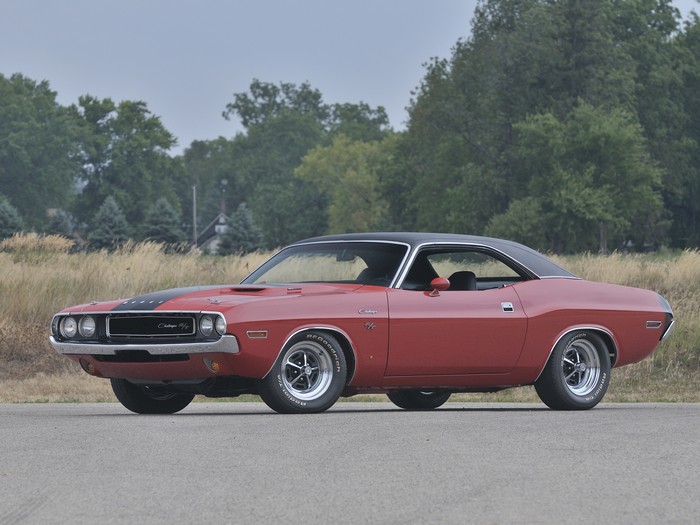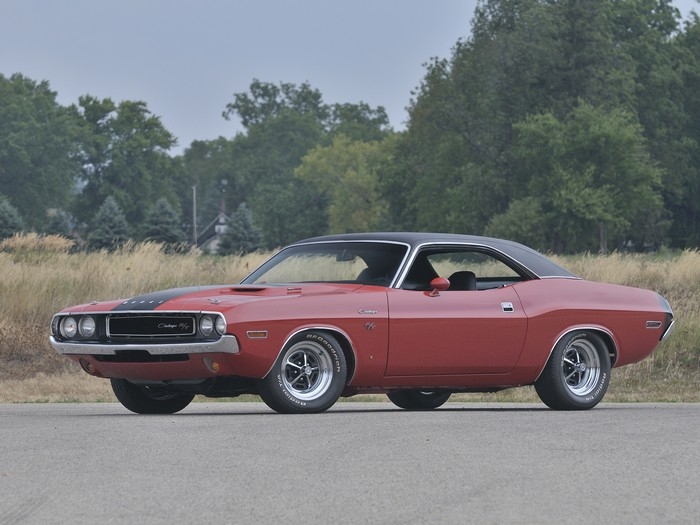
• 383-ci Magnum engine
• 4-barrel carburetor
• Automatic transmission
• Air conditioning
• Power steering
• Power brakes
• Dual exhaust
• Custom interior
• Black vinyl top
• Pioneer CD player
• Space-saver spare and jack
• Broadcast sheet
• Owner’s manual
(Introductory description courtesy of Mecum Auctions.)
SCM Analysis
Detailing
| Vehicle: | 1970 Dodge Challenger R/T |
| Years Produced: | 1970–74 |
| Number Produced: | 9,067 (383 R/T hard top only) |
| Original List Price: | $3,266 |
| SCM Valuation: | $29,500–$43,500 |
| Tune Up Cost: | $200 |
| Distributor Caps: | $25 |
| Chassis Number Location: | Driver’s side dash visible through the windshield |
| Engine Number Location: | Pad on block next to the oil pan |
| Club Info: | www.chryslerclub.org |
| Website: | www.challengerforumz.com |
| Alternatives: | 1970 Plymouth ’Cuda, 2012 Dodge Challenger R/T, 1970 Ford Mustang Mach 1, 1970 Chevrolet Camaro Z/28 |
| Investment Grade: | C |
This Challenger R/T, Lot F179, sold for $36,040, including buyer’s premium, at the Mecum St. Charles sale in St. Charles, IL, on October 25–27, 2012.
I’ve always been a muscle-car nut, especially when it comes to E-body Chryslers. My first car was a genuine U-code 440 Magnum Dodge Challenger R/T, similar to our subject car.
When I was a kid in the late ’70s, muscle was cheap. If you wanted to go fast, cars like this Challenger were what you bought. They were common, inexpensive, and they had it where it counted — in horsepower and torque.
Late to the party, life of the party
In 1970, the Big Three were still vying for the hottest car on the drag strip. “Win on Sunday, sell on Monday” was still moving V8s and 4-speeds off car lots across America. Although they were late to the game, Chrysler’s new-for-’70 E-bodies found eager buyers.
The E-body platform was the basis of both the Dodge Challenger and its cousin, the Plymouth Barracuda. The Challenger was offered as the more upscale choice, with more creature comforts, styling options, and a slightly longer wheelbase than the Barracuda. Although the cars look similar, they actually share no sheet metal.
Performance versions of these cars, such as the AAR ’Cuda, Challenger T/A, R/T, and anything with a Hemi have become icons of the muscle-car world. The rarest cars with the best options easily brought six-figure prices at auction before the muscle market crash of 2008. Lesser cars took a harder hit as values dropped, but they’ve been slowly improving since.
Road- and track-ready
The Challenger R/T (Road/Track) option came standard with the stout 383/335 Magnum with a single 4-bbl. That’s what’s fitted between the fenders of our subject car. Optional Challenger R/T engine choices consisted of the 440 Magnum with either a single four (375 hp) or triple deuces (390 hp) up top. Buyers with deeper pockets and good mechanics could opt for the monster 425-hp 426 Hemi.
This was the era when you could walk into your friendly Dodge dealer and order a car built to your specifications. Optional engines, trim levels, creature comforts, body graphics and even steering wheel choices created hundreds of possible combinations. Bold colors, known as the “high-impact” colors, optioned with blackout hoods and bold stripes created Mopars that looked great and smoked tires all over the country.
And I can sure vouch for that. I built up my car — which cost me $500 in 1978 as an engineless roller — with a healthy 383 and a 727 auto, like our subject car. It was no slouch and could hold its own against a lot of other contemporary muscle. One time, I accidently got mine airborne while drag racing a friend’s Nova SS 396 on a deserted country road.
I wasn’t thinking about collector-car values when I was lined up with that Nova — or when I had the choice to lift and lose, or to stay on the throttle until it was too late to avoid a dip in the road. Who cared about rarity or values? At the time, all that mattered was the fleeting glory of being top dog for a night.
I’m sure a lot of these muscle cars were treated that way at some point in their lives. Many ended up wrecked, which certainly has some bearing on good cars’ value today. For those of us who drove them to their limits, well, let’s just say it’s amazing we survived to tell the stories of our youth. But I did beat that Nova, and my Challenger lived to race another day.
A real R/T
Throughout the muscle era, Chrysler used specific codes in the VIN to identify trim levels and engine selections. Our subject car was born as a genuine 383 Challenger R/T, as denoted by the “N” in the VIN.
While you see other makes and models that were “believed to be” original all the time, it’s much more difficult to pull that off with a Mopar because of the VIN.
Our subject car was also accompanied by its original Broadcast sheet, which helps to further solidify the original configuration and options. Chryslers also used fender tags, which contained all the production-line build and option codes. Often, these tags are missing. Our subject car’s tag is intact.
The engine bay appears to be very correct and is not overdone to a glossy standard. This is also a rare factory air example, which was not all that common for guys who checked the R/T box in 1970.
Not quite stock
This car has a few customizations. There is a brushed aluminum dash panel and center console trim with red accents, neither of which are factory. The door panel inserts use the same stylish treatment. The owner also opted for a Tuff Wheel, which was not offered until 1971. The seats also appear to be slightly modified and include suede inserts as well as some subtle red custom stitching.
Still, this is a sharp example. The stance is utterly correct — and the Magnum 500 wheels and rear Bumblebee stripe are spot-on. It just looks right. And with that 383, it will be a great cruiser and occasional stoplight weapon, just like it was back in the day.
A challenging value?
The ACC Price Guide plants the value range on a car like this from $29,500 to $43,500. Two of our comps are for genuine R/Ts that both sold for around the same money as our feature car. The third comp (ACC# 191408) was bid to $27,000 at the McCormick auction in November 2011. This was a “built” R/T replica with a 440 Six Pack added.
I intentionally added that repica in the mix. You’ll rarely see them achieve the same valuation as a real-deal R/T — even compared with one with the base engine.
Keep in mind that colors and options can affect value as well. Given the minor custom touches to our subject car, I’d peel off about $1,000 from the price range listed above, which still puts this car right smack in the middle of the market range. Call it a fair deal for everyone involved.
My old Challenger has long since hit the automotive graveyard, but I did snatch up another R/T when the opportunity presented itself. Sliding behind the wheel of mine takes me back in time — every time. I hope this car’s new owner feels the same way. And even if not, I’m sure there are a few hero moments left in it. Just try to keep all four wheels on the ground. 
